
Vibrant and big – but easy – Lisbon is not only beautiful, but one of the oldest capital cities in the world! I posted many of the photos in this series on my Instagram account, Travelknowing, exploring the monuments and the history behind the sights in a photo a day, plus some other other photos that didn’t make it into my original blog post. Enjoy exploring delightful Lisbon!
Rua Augusta Arch and the Great Earthquake of 1775
We start with busy historic Rua Augusta – the central pedestrian street lined with shops and restaurants heading to the huge main square next to the Tagus river.
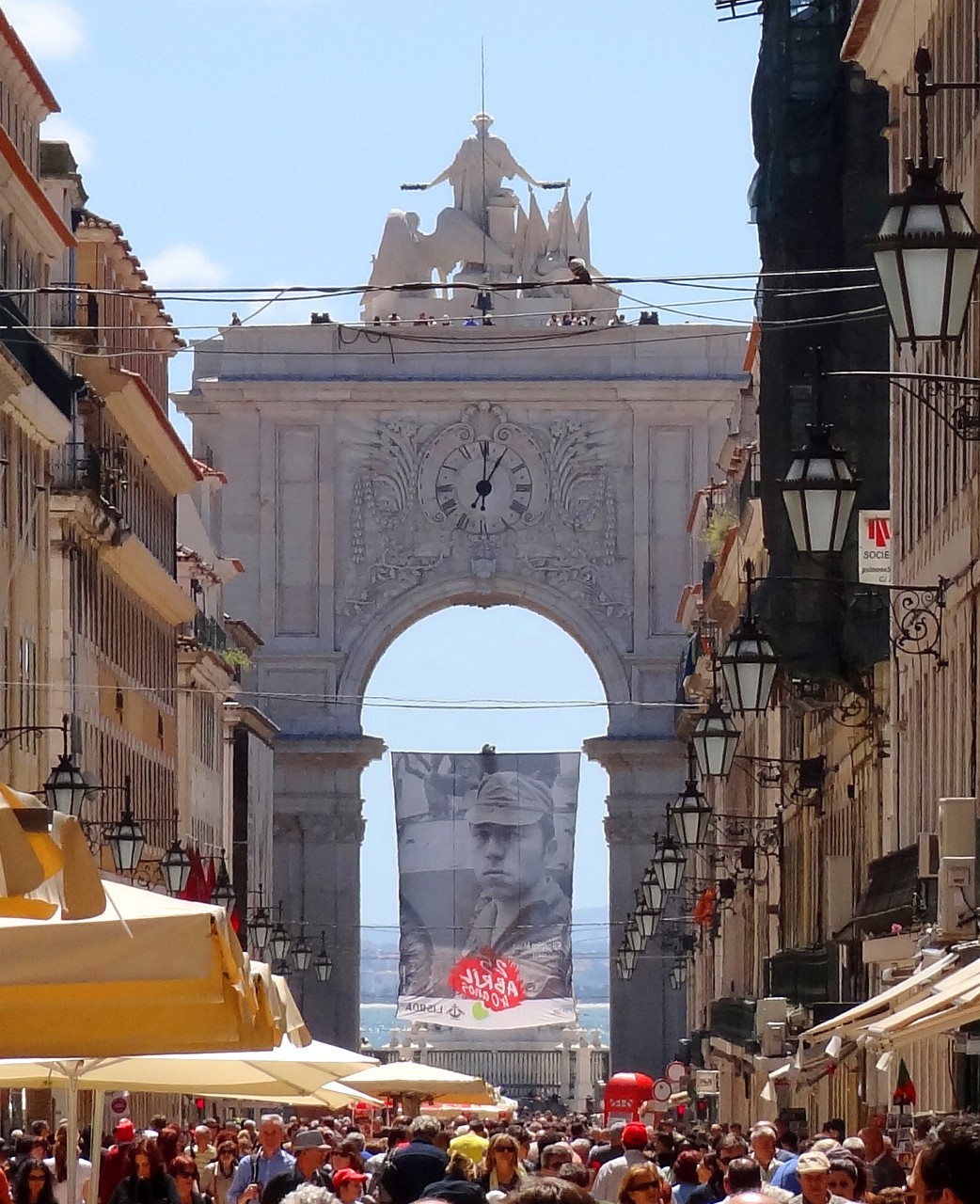
Rua Augusta
Rua Augusta is always busy, but even busier at this joyous time in Portugal’s history – the anniversary celebrations of the Carnation Revolution when Portugal became a democracy!
The Great Earthquake
A huge 9.0 earthquake, followed by raging fires and a tsunami, destroyed 85% of Lisbon in 1775. Known as the Great Earthquake, King Joseph I and his prime minister had several options to rebuild the gutted city and chose to raze to the ground the level area between Lisbon’s hills and rebuild, giving us the big squares and large avenues in the Baixa quarter we see today.
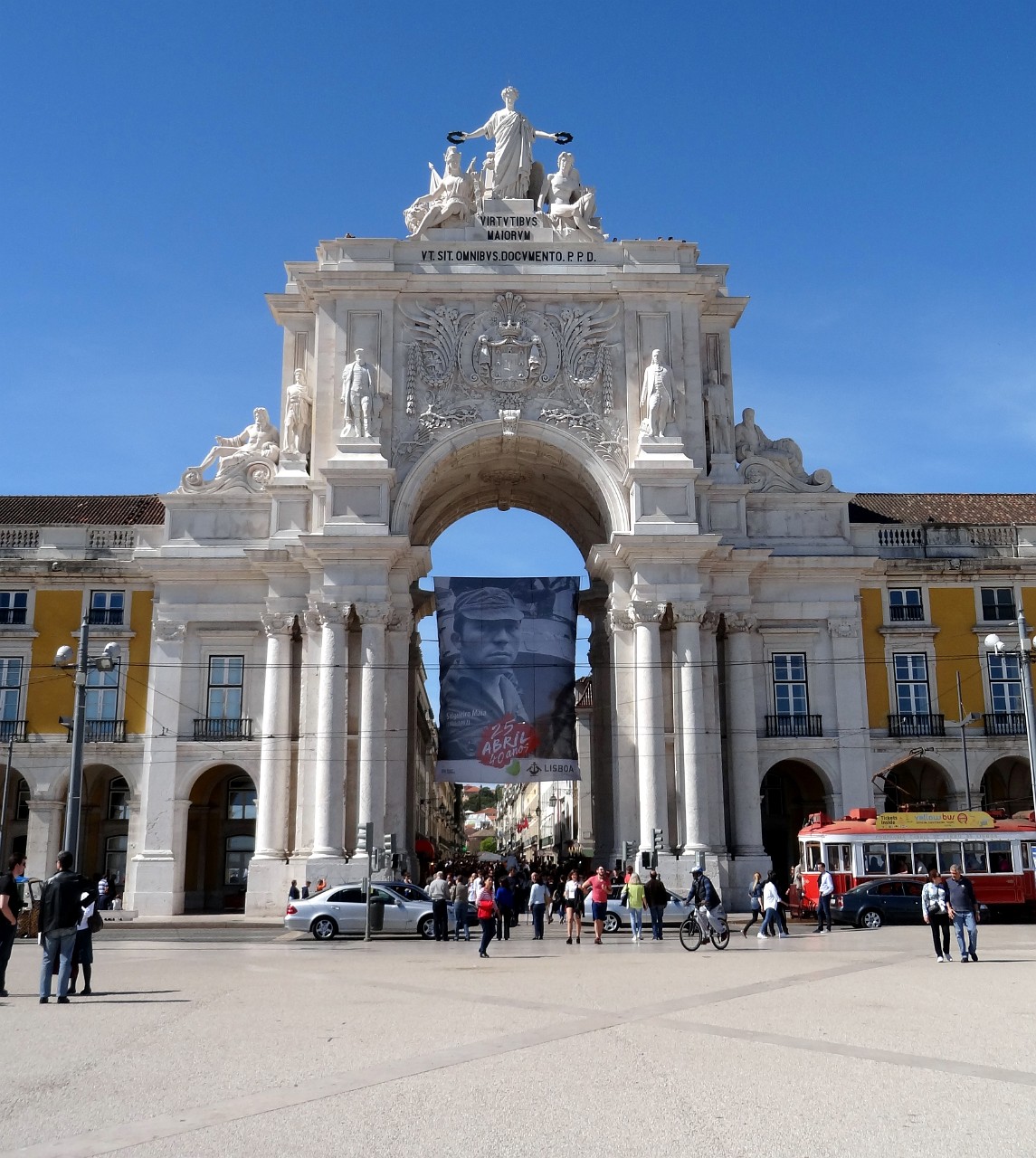
Rua Augusta Arch from Commerce Square
The huge Rua Augusta Arch was built to commemorate the city’s reconstruction after the quake. At over 100 feet tall, it’s colossal! The arch is on huge Commercial Square, a transportation hub next to the Tagus River that you are likely to pass through at least once on a trip to Lisbon.
Ginja – Portugal’s Tasty Liqueur
Largo de São Domingos
Do you want it with or without cherries? That’s the question at A Ginjinha, the historic and tiny hole-in-the wall shop off of Rossio Square that was the very first to commercialize this cherry liqueur, made by infusing wine with the sour Ginja cherry.
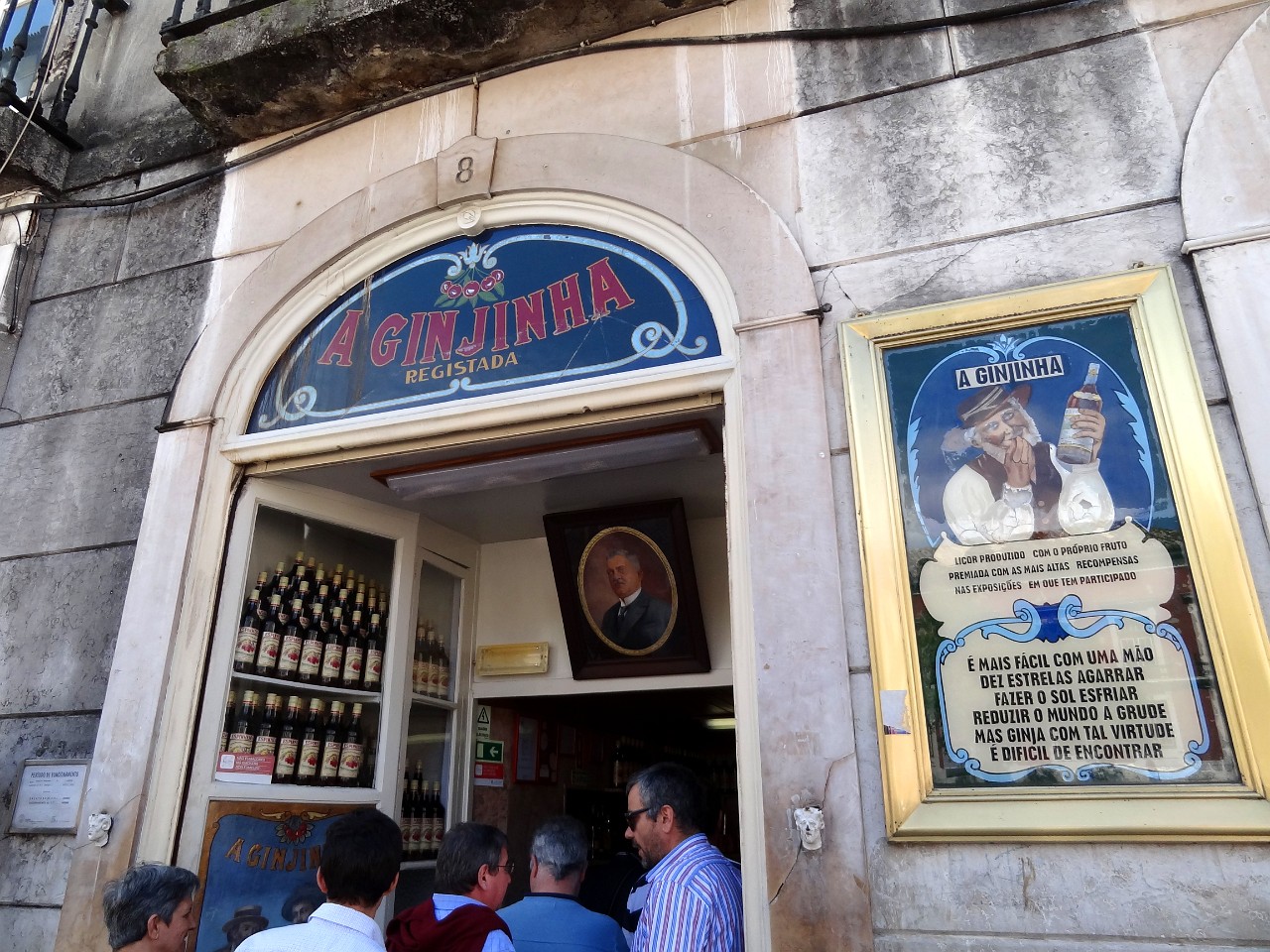
A Ginjinha
Served in a small plastic cup to take and enjoy in the square, it’s a Portuguese favorite and because it originated in Lisbon of course you have to try it! So, what will it be for you? With or without cherries?
Memorial to the Jewish Victims of the 1506 Massacre
Largo de São Domingos
A terrible part of European history is the pogroms against the Jewish people. After sipping your Ginja, walk over to this nearby monument and take time to think about what happened in this square in 1506, memorialized in this simple monument.
What happened? You’ve likely heard of the Spanish Inquisition which started in 1492 (a few months before Columbus sailed!). Spain expelled its Jewish population and tens of thousands of Sephardic (Spanish) Jews fled to Portugal where they were originally granted asylum in return for payment. But the asylum turned out to be only temporary, the Jews had to leave or convert to Christianity. Forced to convert, they were called New Christians.
In memory of the thousands of Jewish victims of intolerance and religious fanaticism murdered in the massacre begun on April 19, 1506 in this square
The massacre of between 1,000-4,000 of the New Christians began on Sunday in the São Domingos de Lisboa Convent, where people were praying for an end to the drought and plague that was sweeping through Portugal. One of the people saw a light emanating on the face of Christ on a crucifix over a chapel altar – a miracle!
More and more people gathered to witness the divine sight. But one of the New Christians, a converted Jew, said how can a piece of wood work wonders? This incensed the people who said it was a miracle and they grabbed the unbeliever, dragged him out, beat him to death and burned his body in front of the square. So the massacre began, incited by the Dominican Friars who promised absolution for sins committed over the previous 100 days to those who killed the “heretics”. All New Christians that could be found on the streets were murdered, their bodies burnt by the Tagus river or Rossio. But the pogrom didn’t stop there, when the New Christians could no longer be found on the street, they were dragged from their homes and churches. The 4 day bloodbath continued until Tuesday when the Royal Guard finally arrived, arrested and executed the two Dominicans who had led the riot. (Sources: Jewishwikipedia.info and Wikipedia)
Escadinhas de São Cristóvão – Saint Christopher’s Stairs
I just love walking tours and without the Alfama Tour, we would have been hard pressed to find the practically hidden entrance to this delightful stairway and mural in the Mouraria Quarter. The Mouraria (Moorish) neighborhood is Lisbon’s old medieval quarter tumbling down the hill below Saint George’s Castle, and just one of the 2 neighborhoods that survived the Great Earthquake of 1775.
Not only is this stairway a great way to get up to the castle, this neighborhood is credited with being the place where Fado began – that soulful traditional music of Portugal.
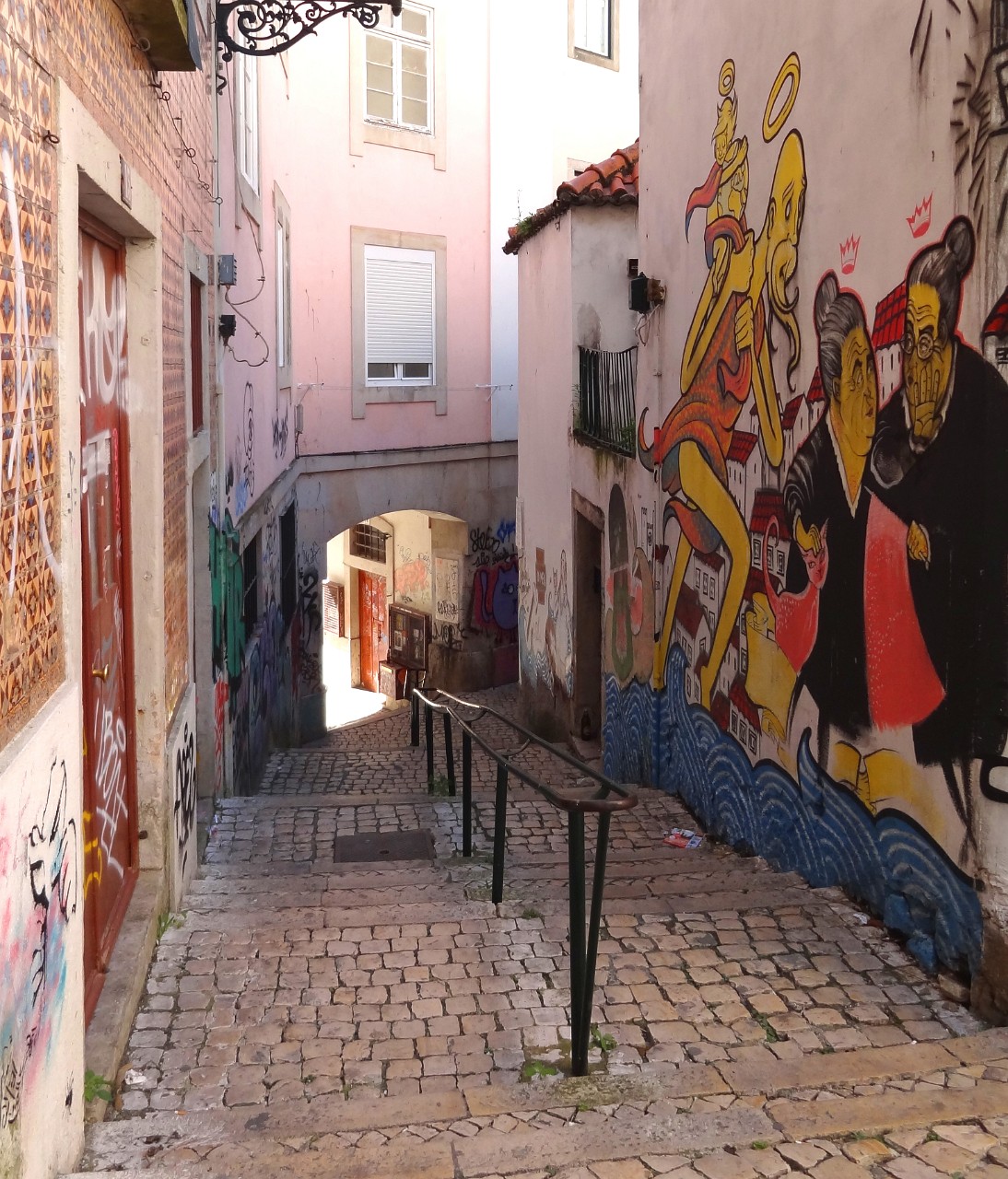
Escadinhas de São Cristóvão
These stairs lead up to St. Christopher’s Church at the top, and the Saint himself is depicted in this part of the mural – his famous legend is carrying an unknown child across a river who on the other side revealed himself to be Christ – so he’s the patron saint of travelers!
Saint Christopher on wall mural
The two matriarch’s dressed in traditional black are representative of the typical Portuguese gossip queens, reigning supreme in the old neighborhoods like this one.
I was enchanted with this marvelous wall mural, full of symbolism and Fado. We walked through this shortcut to the top several times day and night just to see it.
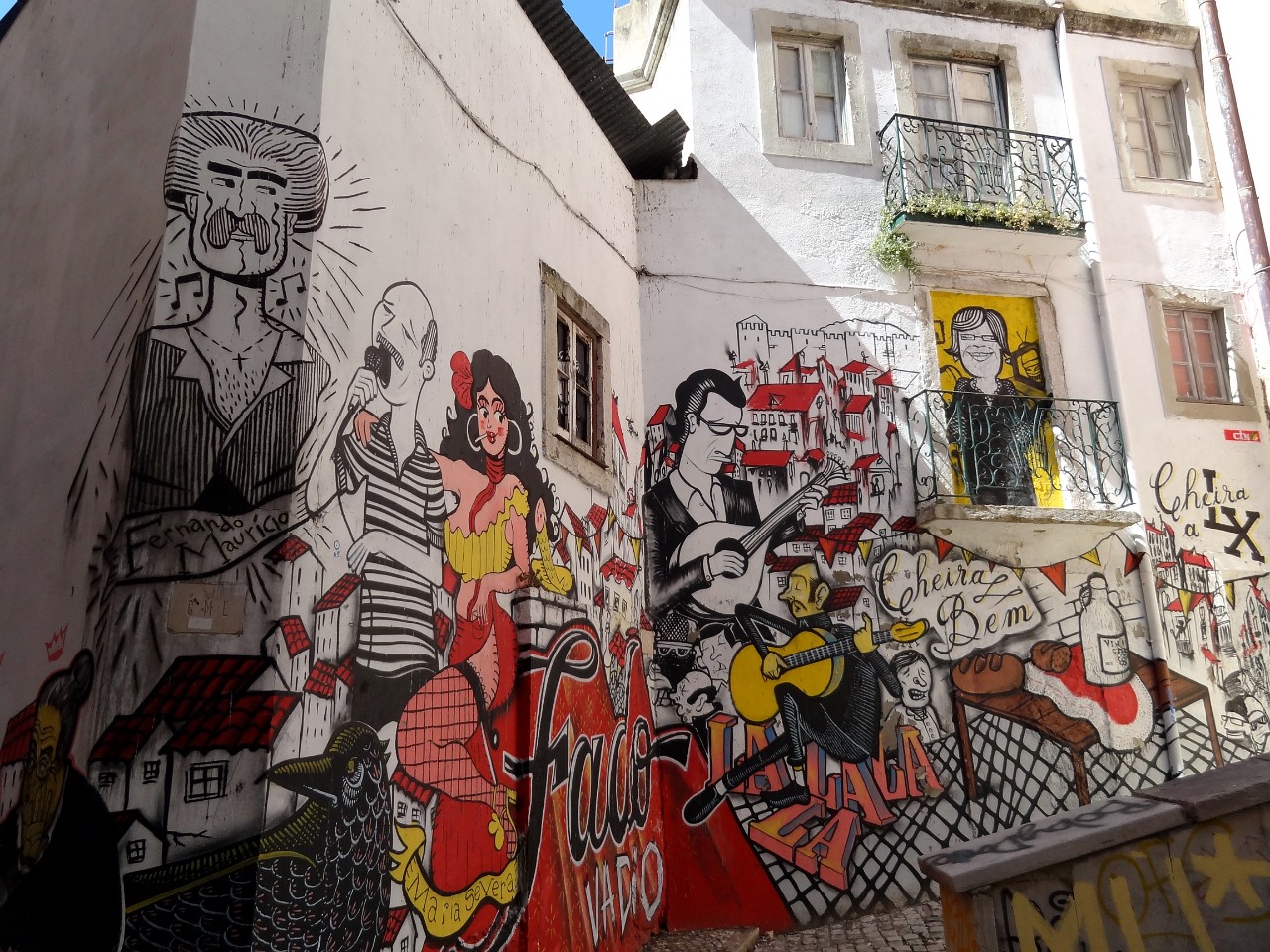
Fado Vadio mural, Escadinhas de São Cristóvão
Because Fado originated in this old neighborhood, a huge part of the mural is a tribute to that soulful, most often melancholy, music genre, inscribed in the UNESCO Intangible Heritage List in 2011.
Fado is depicted in the mural with symbolism and song and two famous Fadistas from the Mouraria – Fernando Maurício who was born in the 1900’s, and Maria Severa Onofriana, an 1800’s prostitute and Fadista made famous by a novel A Severa that was turned into a play and then a film.
Fado wall mural at Escadinhas de São Cristóvão
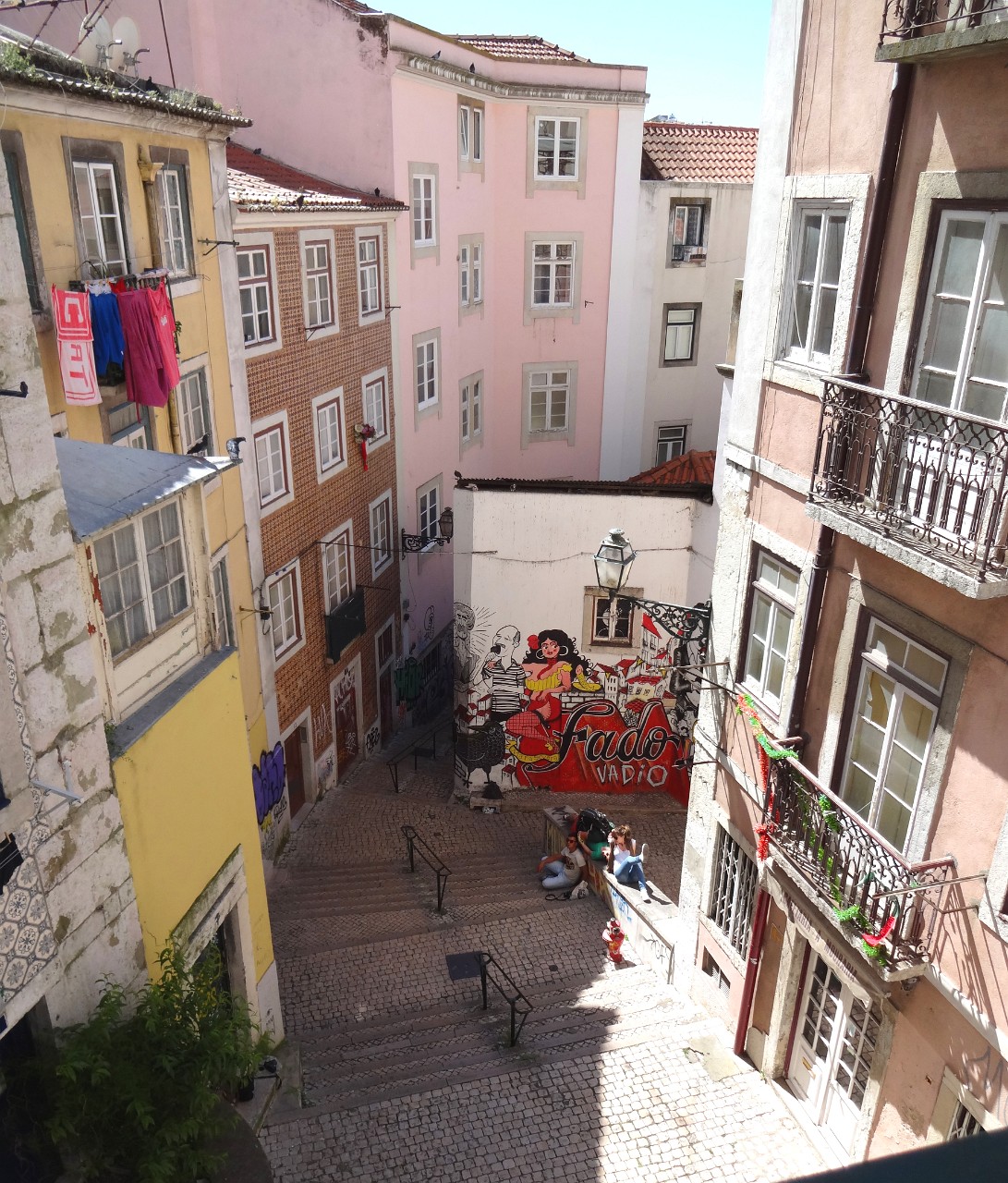
Fado Vadio mural and the Saint Christopher stairs
The mural was a project of the Moviemento os Amigosde São Cristóvão, a community organization in Lisbon, and a wonderful contribution and tribute to this historic neighborhood. Don’t miss it!
Decorative Tiles
One of the first things you’ll notice in Lisbon are the beautifully tiled buildings – yes, tiled! The ceramic tiles (called Azulejos) are everywhere – decorative tiles in geometric patterns, story telling tiles, even 3D looking tiles!
Check out the bouquet in a stocking on this marvelously tiled building!
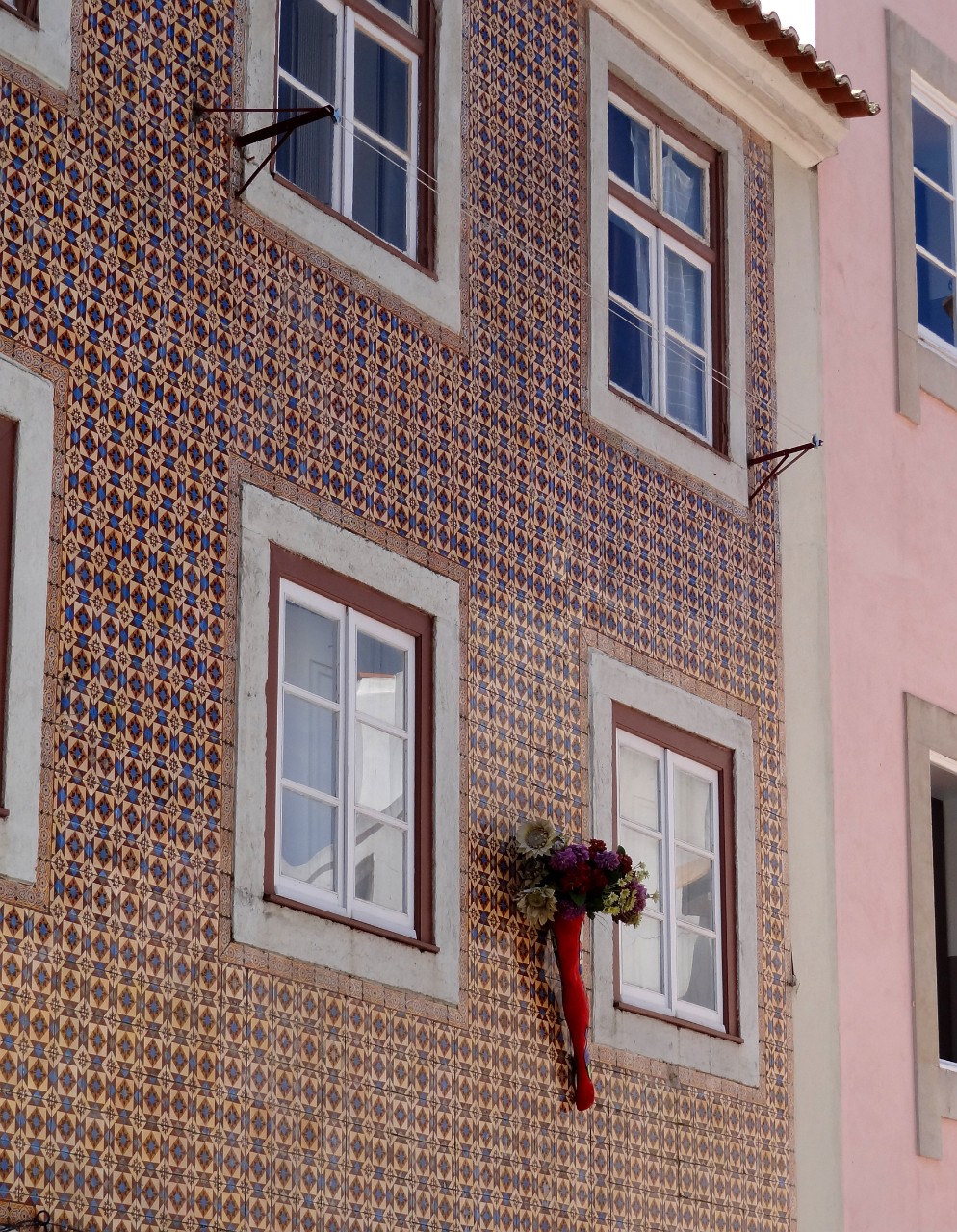
House tiles on Escadinhas de Sao Cristovao
One of the many buildings that have story telling murals in tile is found on the way to Saint George’s Castle.
Saint Anthony lived nearby and on a street that bears his name, Rua do Milagre de Santo Antonio (Street of the Miracles of Saint Anthony), you’ll find 3 tiled panels depicting his miracles.
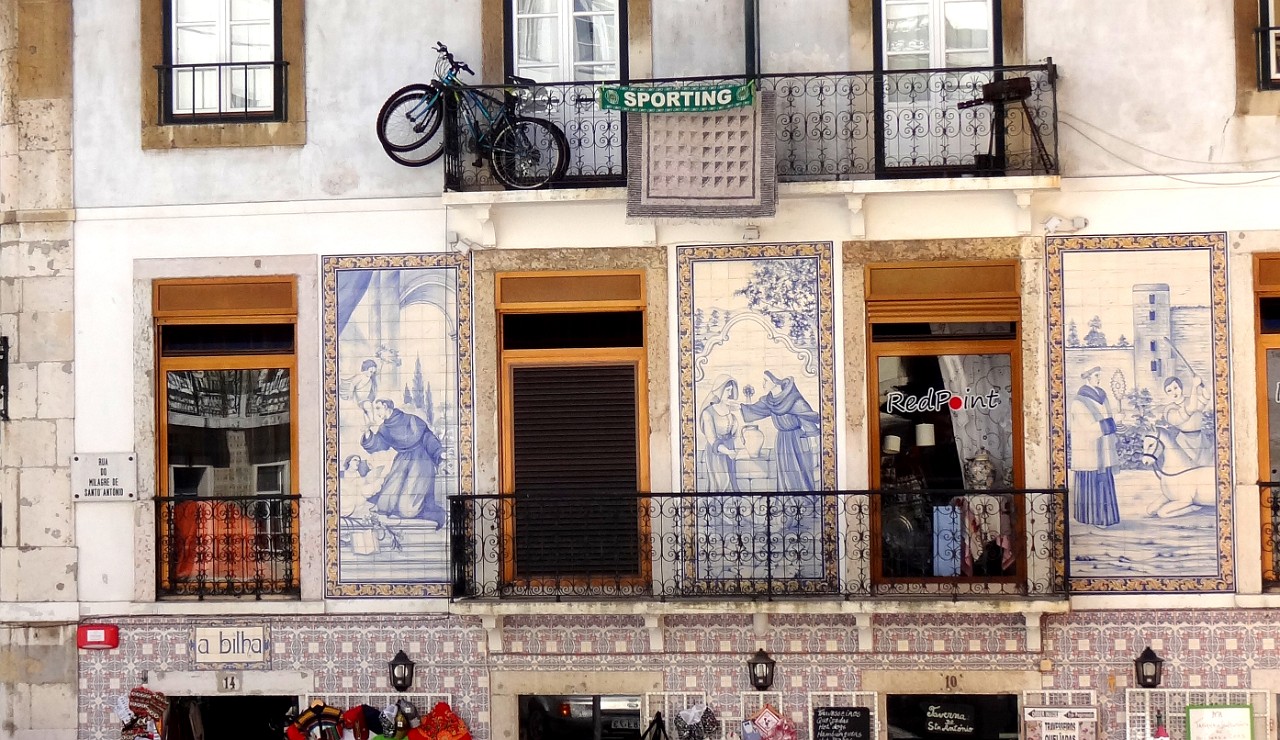
Saint Anthony’s miracles in tile: Miracle of the Fishes, Miracle of the Jug, Miracle of the Mule
A 3D looking tiled building is in the Alfama district.
3D looking tiles in the Alfama
We went to the National Tile Museum to see lots of gorgeous tile murals saved from cathedrals, mansions and monuments and learn about this beautiful cultural phenomenon that just says – Portugal!
The Alfama Quarter
Up and down stairs and narrow passages, the Alfama is the oldest district in Lisbon and one we not only loved wandering in the daytime, but came back to in the evenings to listen to some Fado, that distinctive music genre that originated in Lisbon.
Inscribed on the UNESCO World Intangible Heritage list in 2011, Fado means destiny or fate and it’s soulful, longing type of songs are usually sung by a single Fadista accompanied by a guitar. It’s a wonderful experience to hear Fado sung in Lisbon!
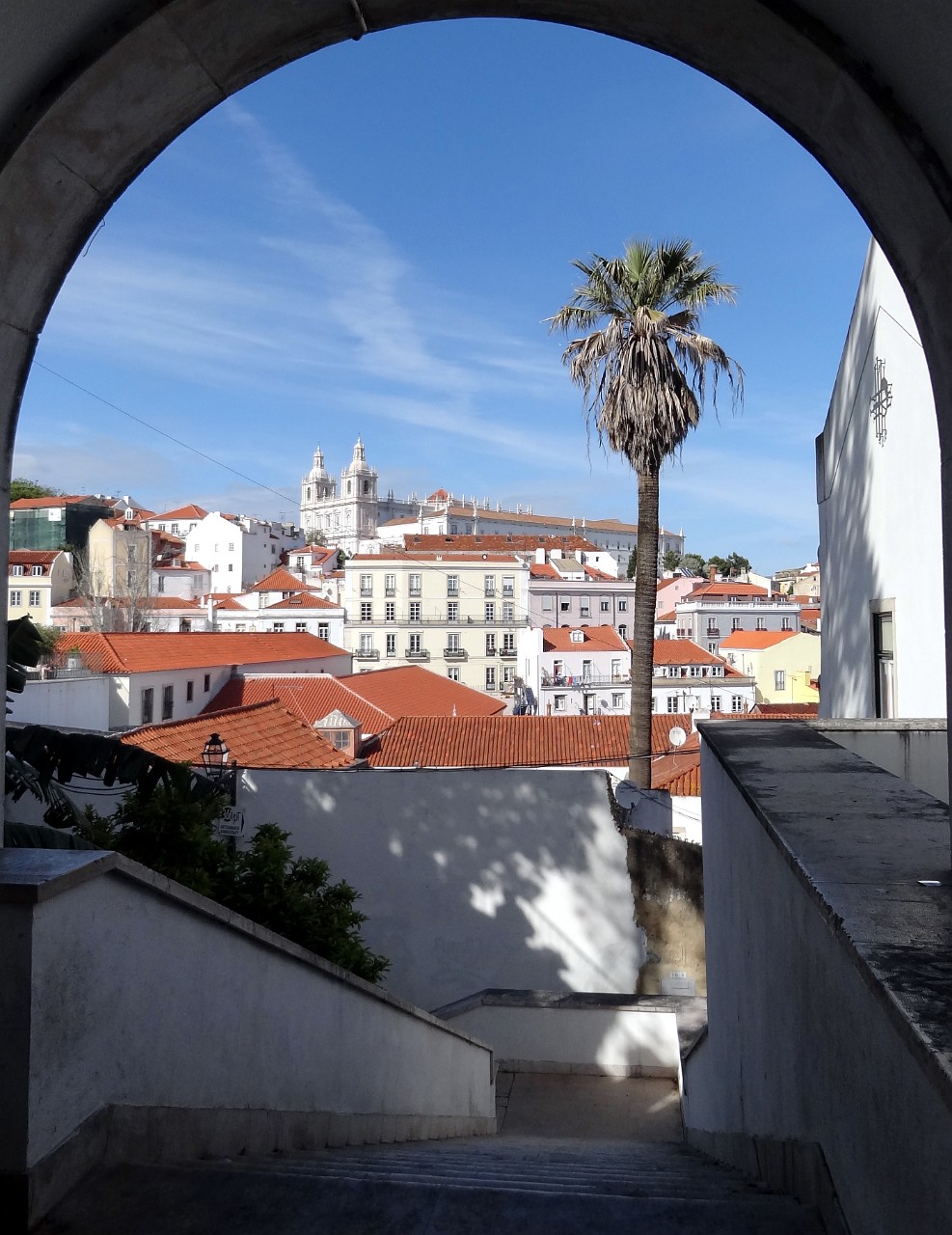
Stairs down to the Alfama
In the old days, the Alfama quarter was outside of the city walls and was associated with poverty and squalor – where the sailors and dock workers lived.
But it was the Moors who originally gave the Alfama it’s atmosphere and tangle of streets, and also it’s name – from the Arabic Al-hamma meaning hot fountains or baths in reference to the hot springs found in the area.
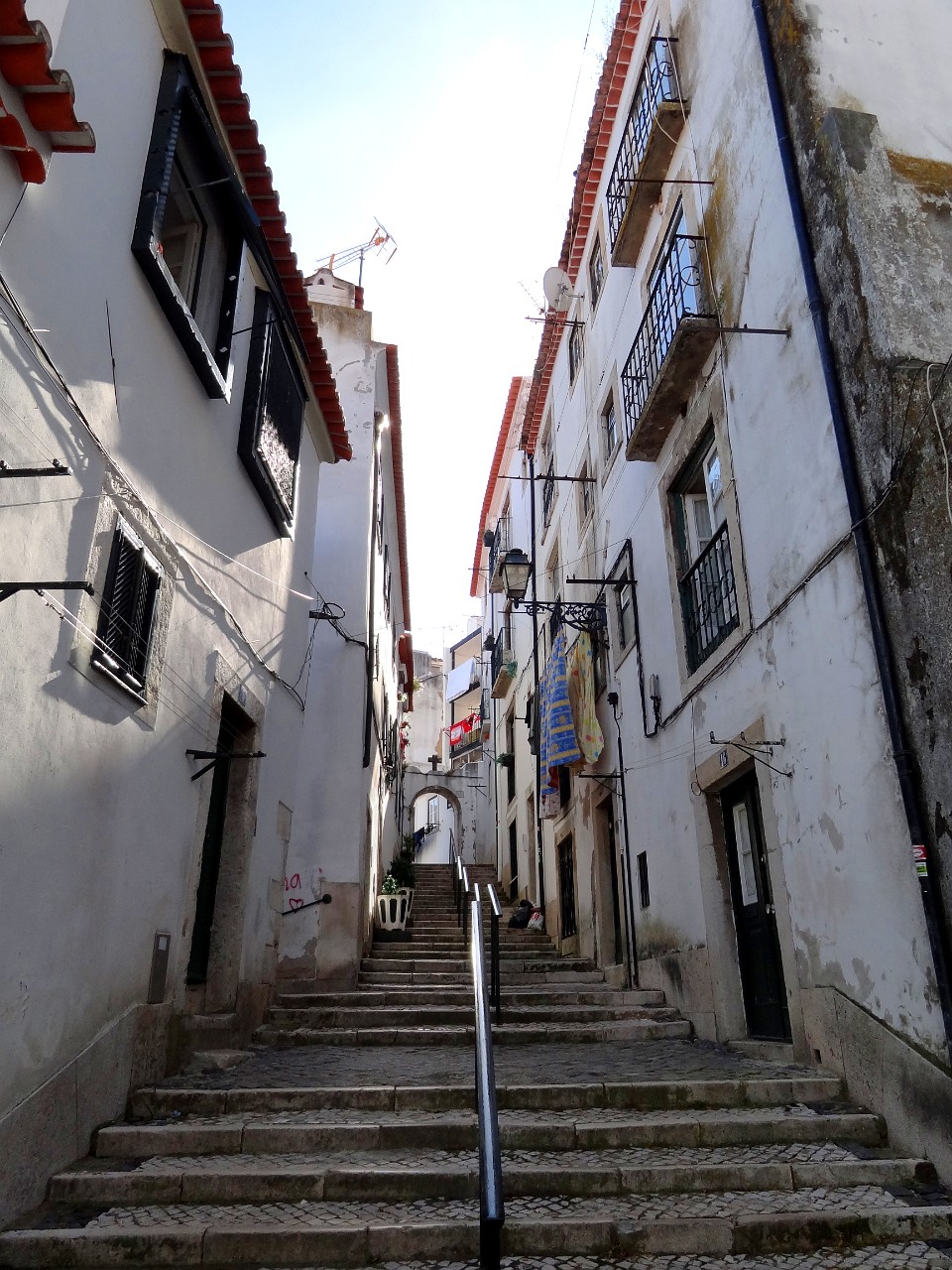
Rua da Regueira in the Alfama quarter
Today it still has it’s dilapidated charm and feels like a real neighborhood with people who’ve lived here all their lives enjoying the tiny plazas and the little shops and restaurants that are around one corner or another.
One shop that we came back for was Pastelaria Alfama Doce for their oh so special pastry called…Alfamas! Don’t miss a stop here for this unique treat!
Santa Justa Lift
Have you ever seen an elevator that looks like this? There are plenty of trams to get you up and down Lisbon’s hills, but the Santa Justa Lift is the only vertical lift!
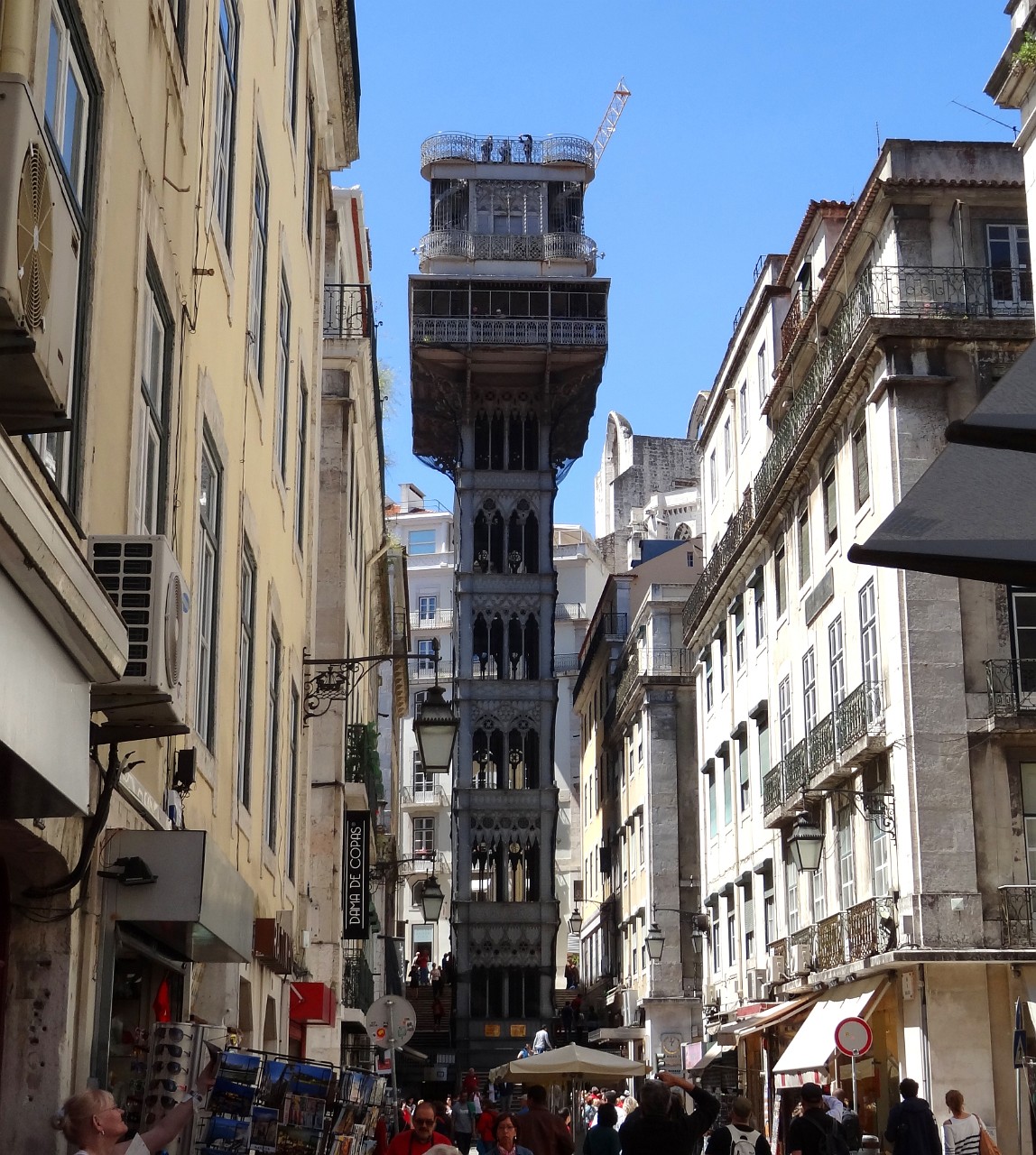
Elevador de Santa Justa
A beautiful ironwork structure built in 1902, you can take it up from the Baixa district to historic Largo de Carmo – where the most important event in the Carnation Revolution of 1974 took place – where the Portuguese Armed Forces forced the resignation of Marcello Caetano, the Prime Minister/Dictator, ending the half century rule of the authoritian regime and the beginning of Portugal’s democracy.
A ticket is expensive and the line long, we just admired the elevator from below and went the hilly way to the historic square.
Tram 28 at Rua da Conceição
One of the Things To Do in Lisbon is take a ride on Tram 28, but go early or late because a ride is standing room only between about 10am and 6pm!
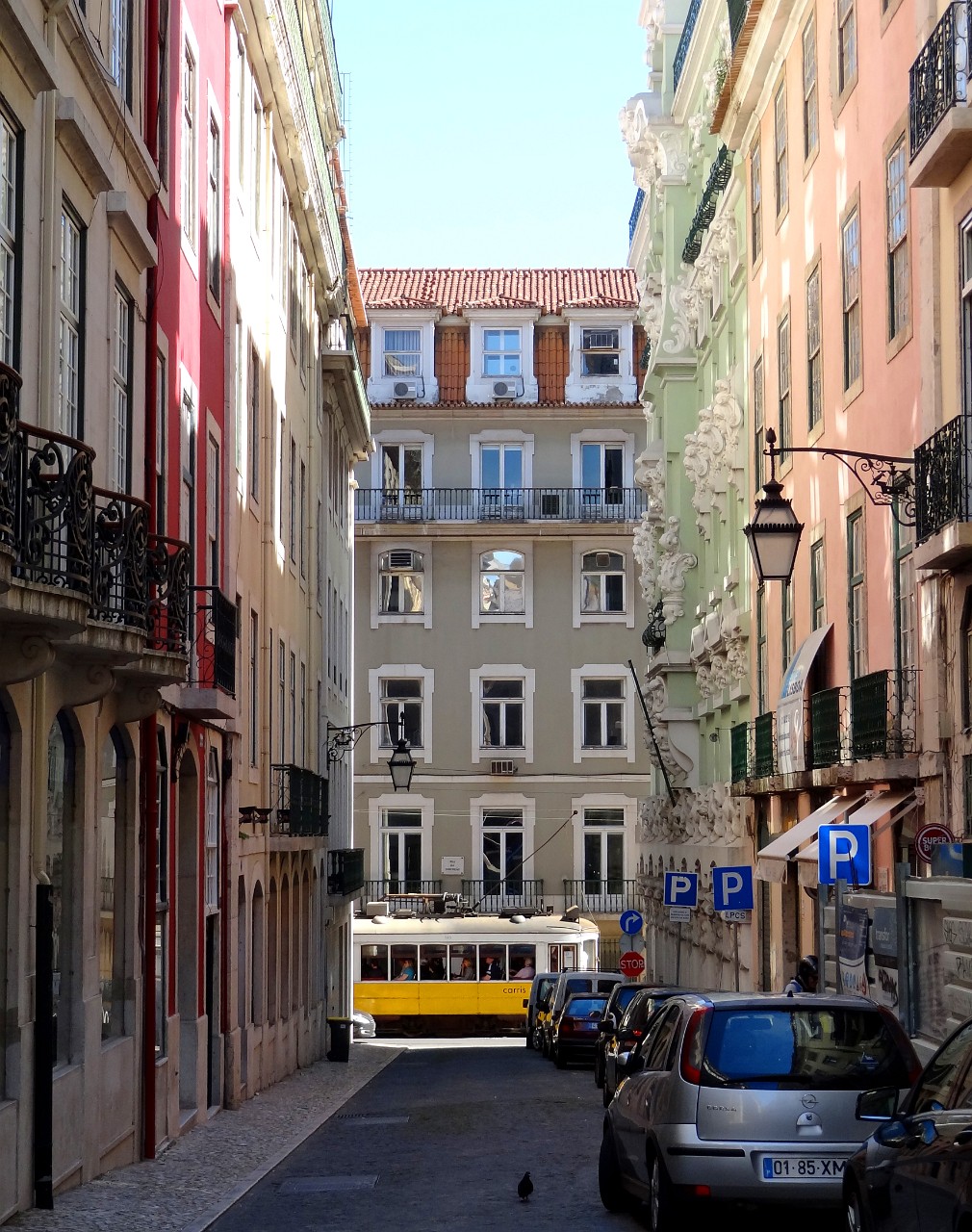
Tram 28 Rua da Conceição
We walked by these beautiful houses and this stop at Rua da Conceição in the Baixa (the flat middle of Lisbon) many times, and made the mistake of waiting for the tram here – get on at one of the end points of the route for a long ride and maybe… even a seat!
Tram 28 standing room only
Day Trip to Sintra
Pena Palace
High on a hill in Sintra is the Pena Palace – the Romanticist castle built on the ruins of a monastery by King Ferdinand in 1847 for a summer palace. Only a 40 minute train ride from Lisbon, Sintra is a top day trip destination, with this UNESCO Heritage Site palace just ONE of the terrific things to see in in this tiny town.
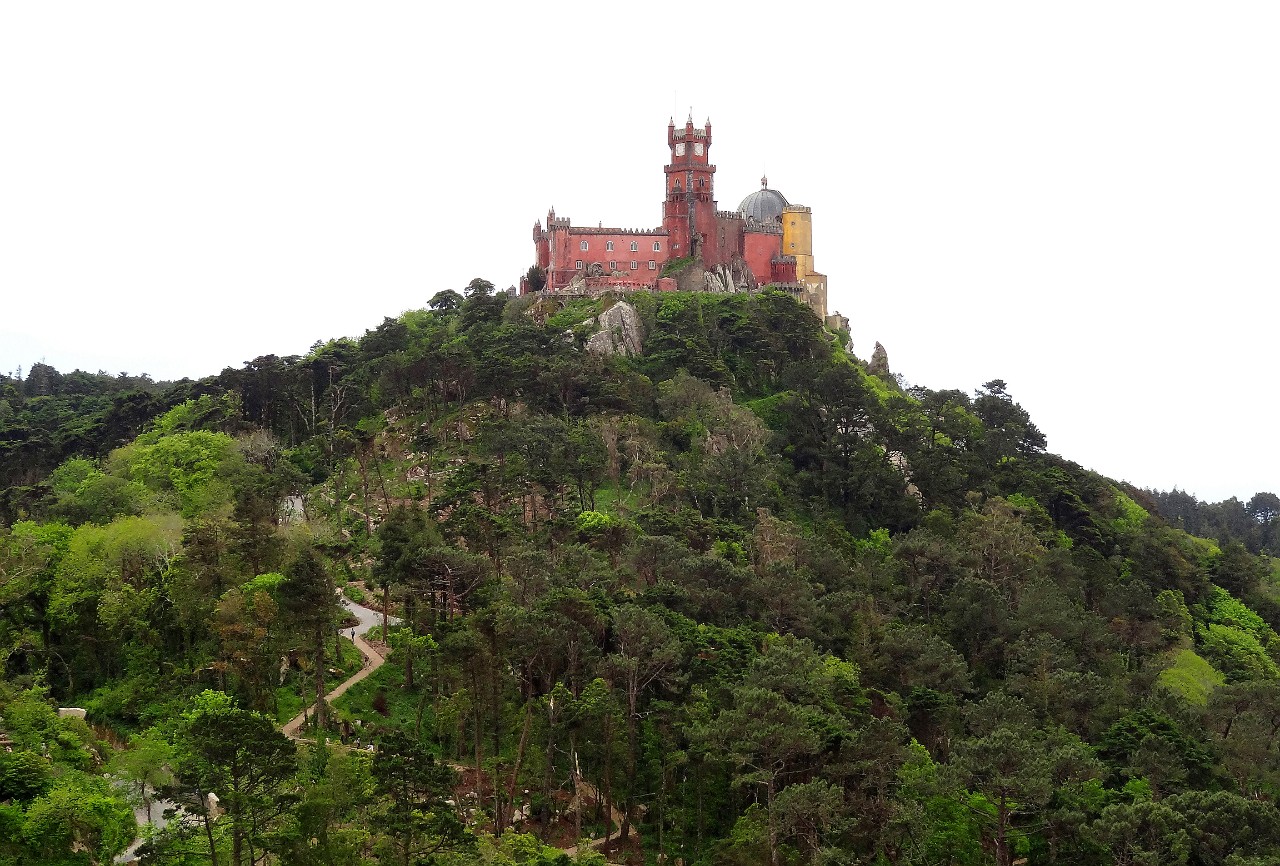
View of Pena Palace from the Moorish Castle
Quinta da Regaleira
Who likes to feel like a kid again? Sintra has a lot of sights but if you love the fabulous fun of hidden tunnels, mysterious grottoes, labyrinths, secret passages and inverted towers, you won’t want to miss the gardens of the Quinta da Regaleira!
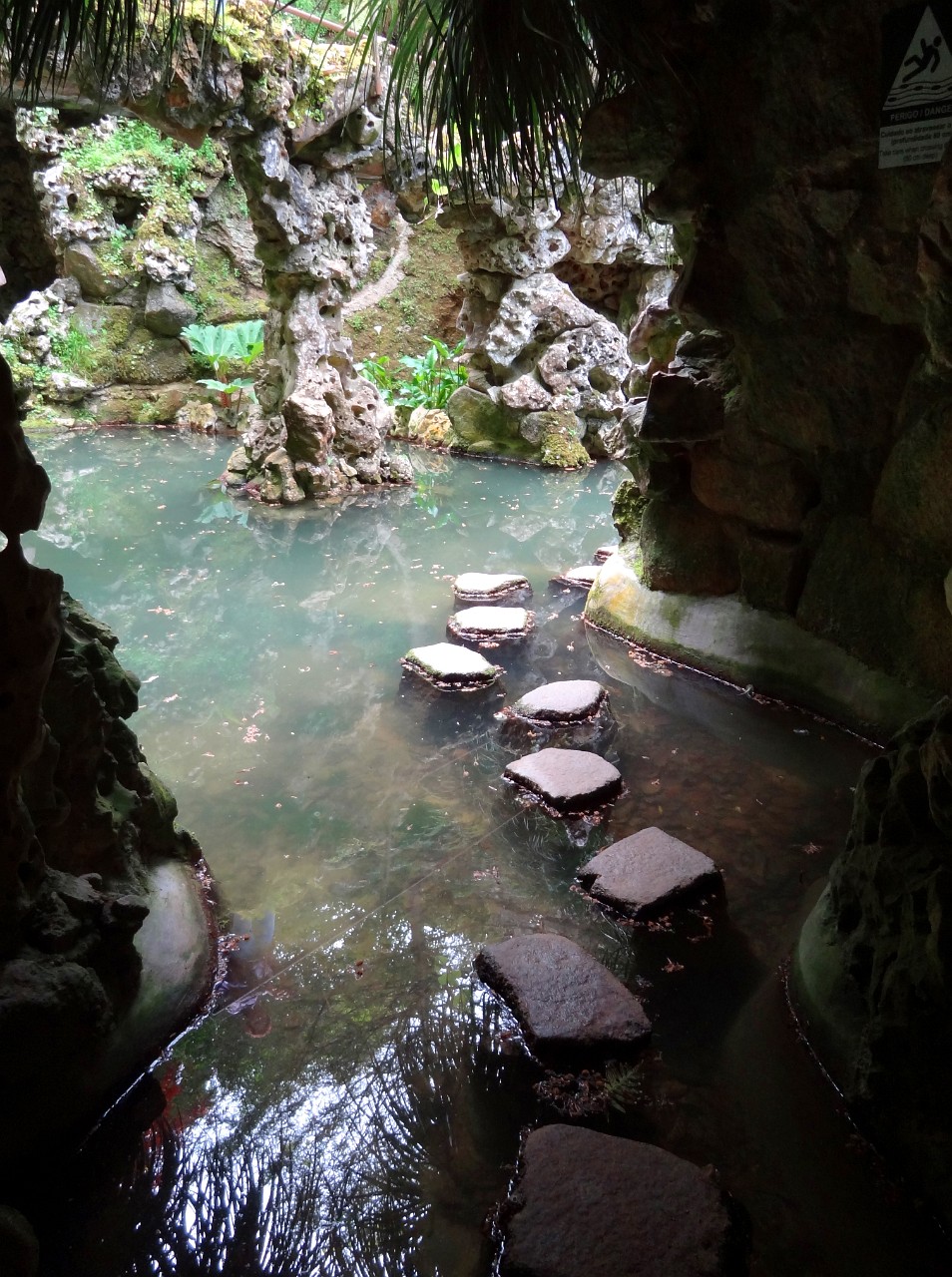
Quinta da Regaleira grotto
The one time residence of a wealthy Portuguese businessman, the ornate Gothic style house is beautiful and interesting to tour but exploring the secrets of the gardens are just a fantasy delight. The property is a UNESCO World Heritage Site – don’t miss it in Sintra!
Day Trip to Belem
Mosteiro dos Jerónimos
The enormous Jerónimos Monastery in Belém was built by King Manuel to thank the early Portuguese explorers for their many discoveries.
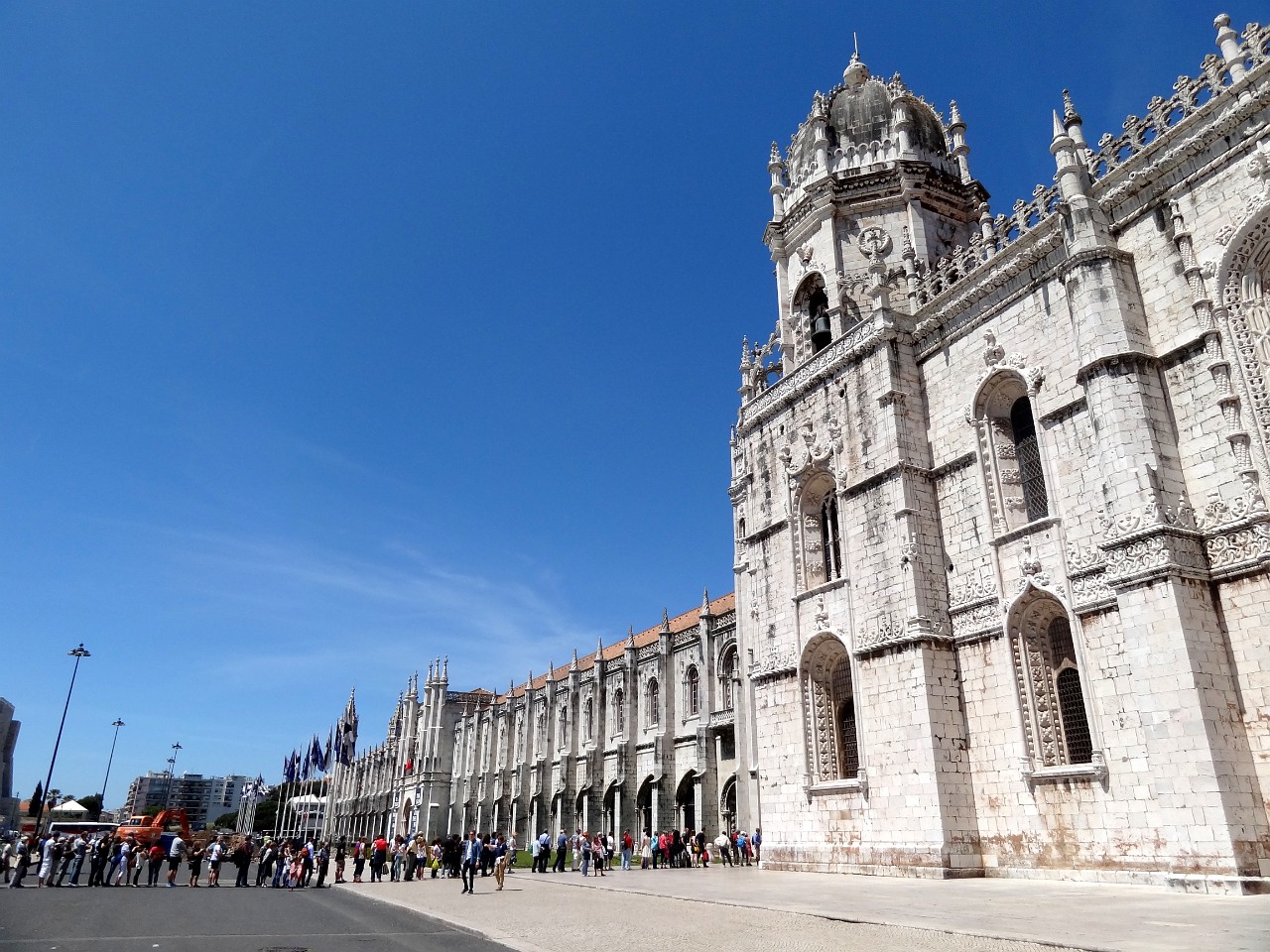
Mosteiro dos Jerónimos
Built in 1501 and completed 100 years later, the huge complex stretches 300 feet along the waterfront and is built in a richly ornate architectural style that became known as… Manueline!
There’s lots to see in Belém, a Lisbon district that is about a 15-20 minute tram or bus ride away from central Lisbon.
Jerónimos Monastery – Church of Santa Maria Portal
The blazingly brilliant white limestone ceremonial entrance to the church at the Jerónimos Monastery with its plethora of statues, starting with Prince Henry the Navigator guarding the entrance in the center of the doors (the Monastery was built to celebrate Portuguese explorers).
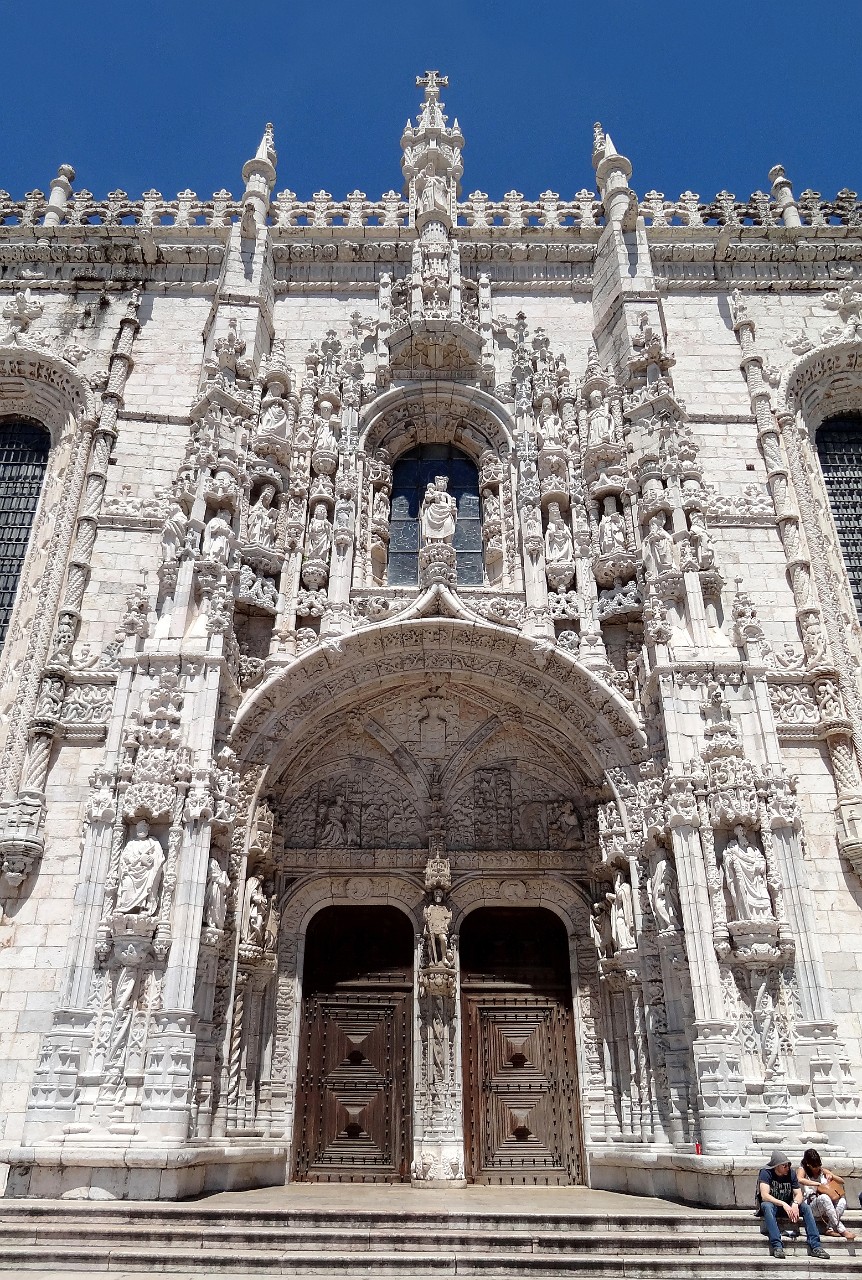
Jeronimos Monastery Church portal
This is Manueline style, that decorative architectural style celebrating maritime might and named after King Manuel.
The Cloister
The lacy and elaborate stonework in the huge cloister of the Jerónimos Monastery is a Manueline two storey marvel.
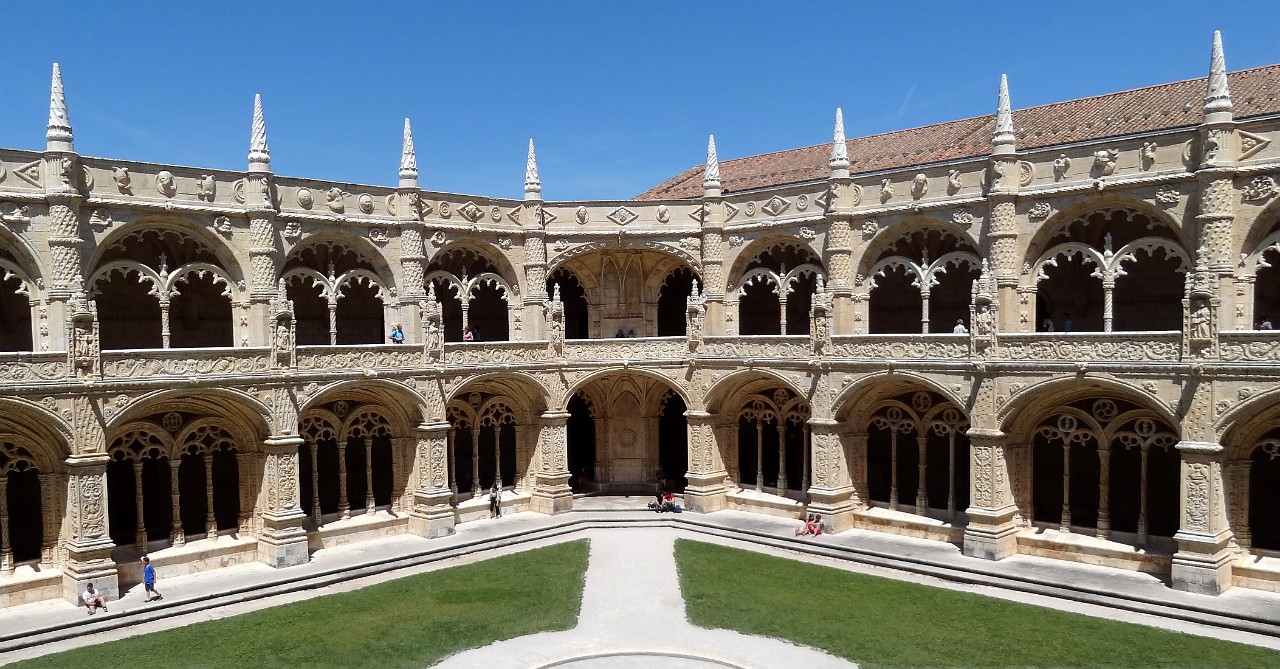
Jeronimos Monastery Cloister
There’s a lot to take in – each of the four sides of the symmetrical cloister is 55 meters (180 feet) long and each arcade inside and out is covered with fanciful carvings and intriguing nautical, religious, and dynastic symbolism. The entire monastery is a UNESCO World Heritage Site.
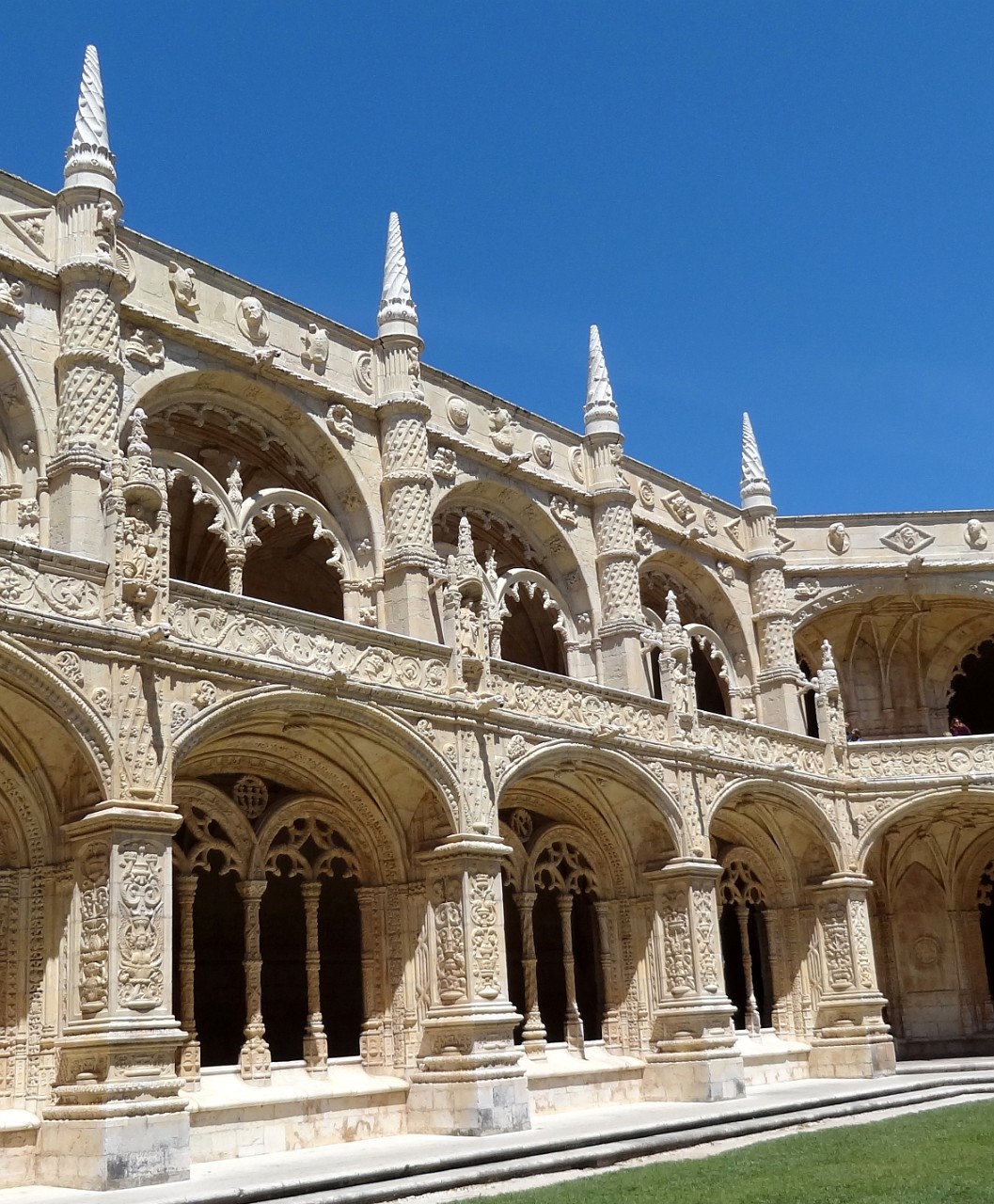
Jeronimos Monastery Cloister
Church of Santa Maria
The oh-so very Manueline Church of Santa Maria in the Jerónimos Monastery, with slender palm tree-like columns decorated with fantastic carvings. I loved looking for all the nautical and exploration symbolism here, with rope-like arches, ships, monsters and creatures from exotic lands.
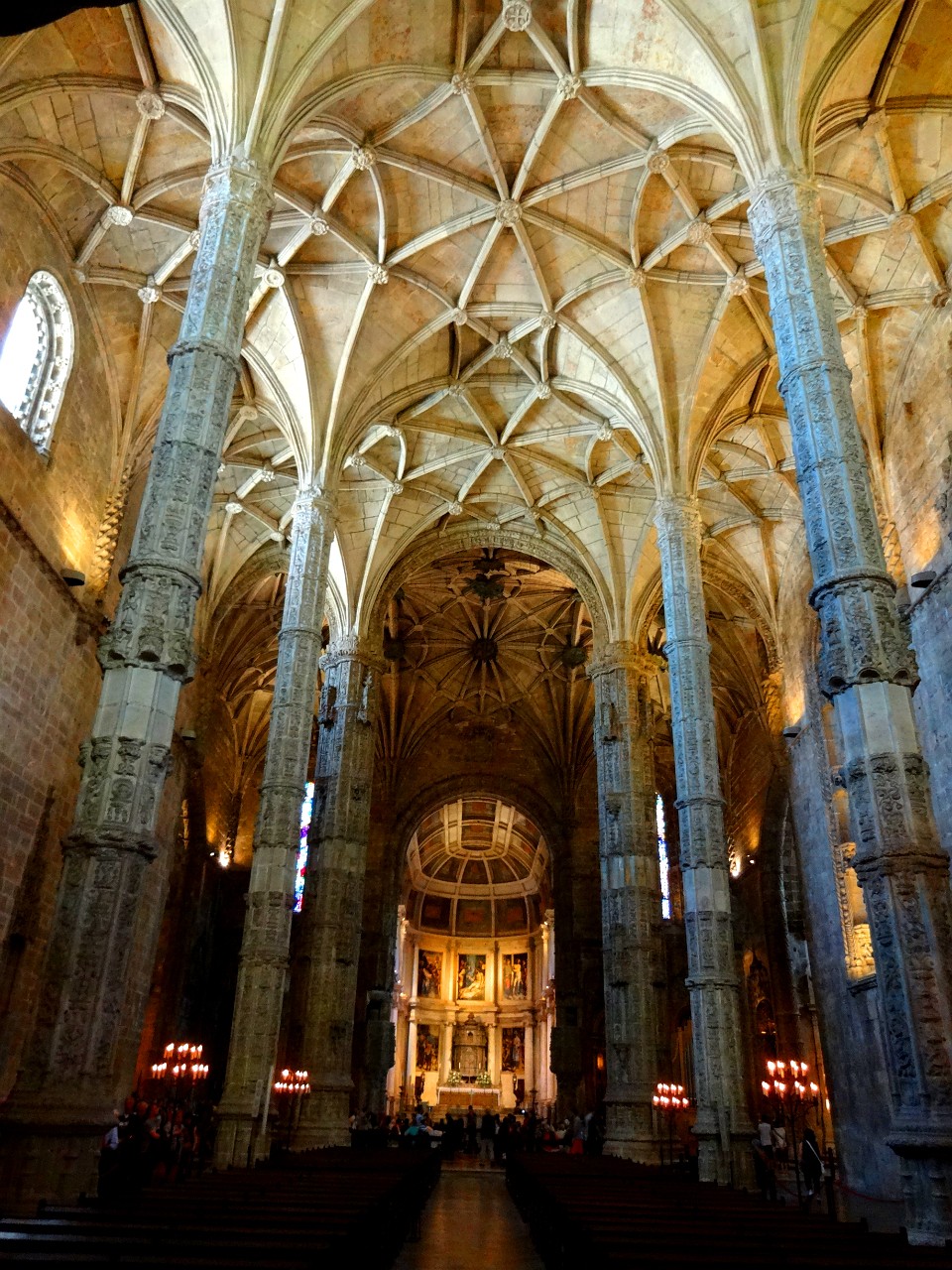
Church of Santa Maria
The history-making Portuguese explorer Vasco da Gama is entombed here, the first European to reach India by sea and the one who launched Portugal’s Golden Age. There’s a memorial to the poet Luis Camões across from da Gama, the poet who turned da Gama’s history making voyage into a epic poem “Os Lusiadas”. The church was my favorite part of our visit to the monastery, no line and it’s free! Don’t miss it in Belém!
Monument to the Discoveries
Prince Henry the Navigator leads the way in the gigantic Monument to the Discoveries on the bank of the Tagus River in Belém. He holds a Caravel, that highly maneuverable trading ship of the Portuguese, and the monument itself is shaped like the prow of a Caravel, with Kings, soldiers, and other important people from the Golden Age of exploration on both sides of the monument behind Henry.
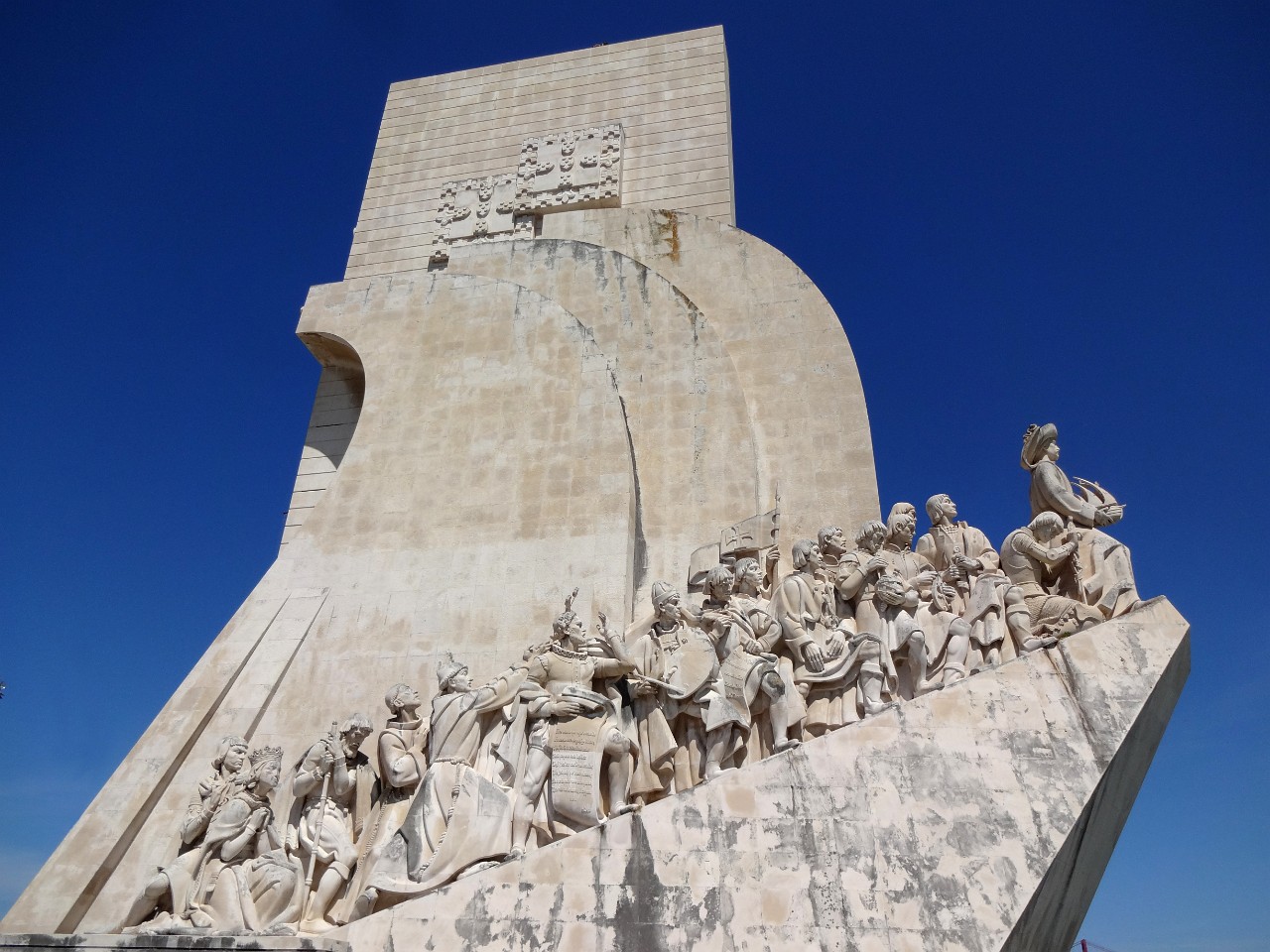
Monument to the Discoveries
Tower of Belém
Built to protect Lisbon from seafaring invaders, this beautiful tower once stood in the middle of the Tagus river! There’s really nothing inside but a series of rooms and stairs to get to the views of the river from the highest points, and close up views of the interesting exterior stonework – stone carved to look like ropes, and plenty of coats of arms.
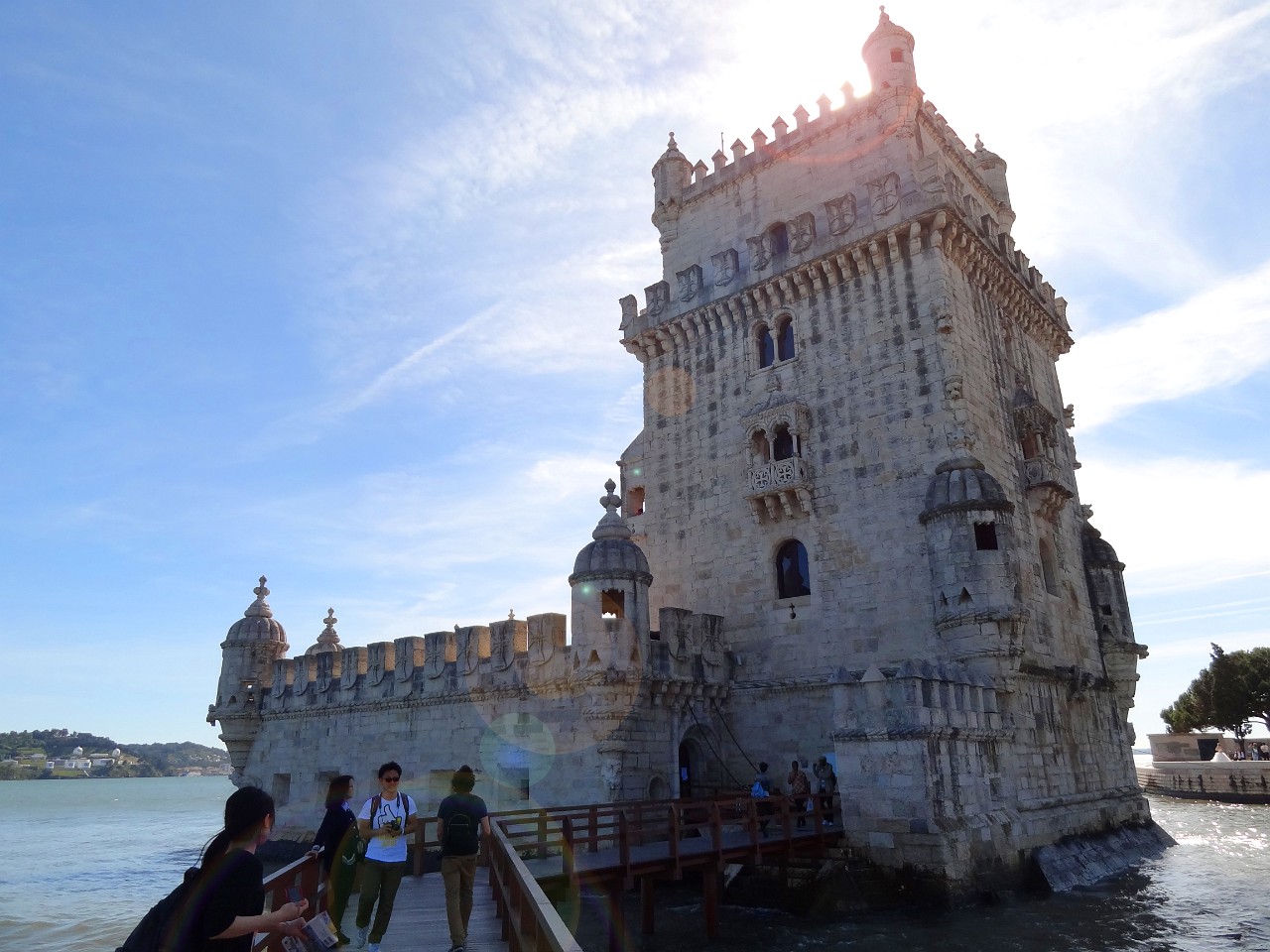
Tower of Belem
Seeing the inside was my least favorite of the things we did in Belem, if you don’t want to wait in another line (and more lines inside to go up and down the many red/green light controlled stairs), I’d say skip the interior and just admire the famous tower from the banks of the river.
Exploring Lisbon Wrap-Up
Lisbon was a delight to experience with lots of fascinating history, beautiful monuments, unique architecture and music, fantastic daytrips, and friendly easy going people.
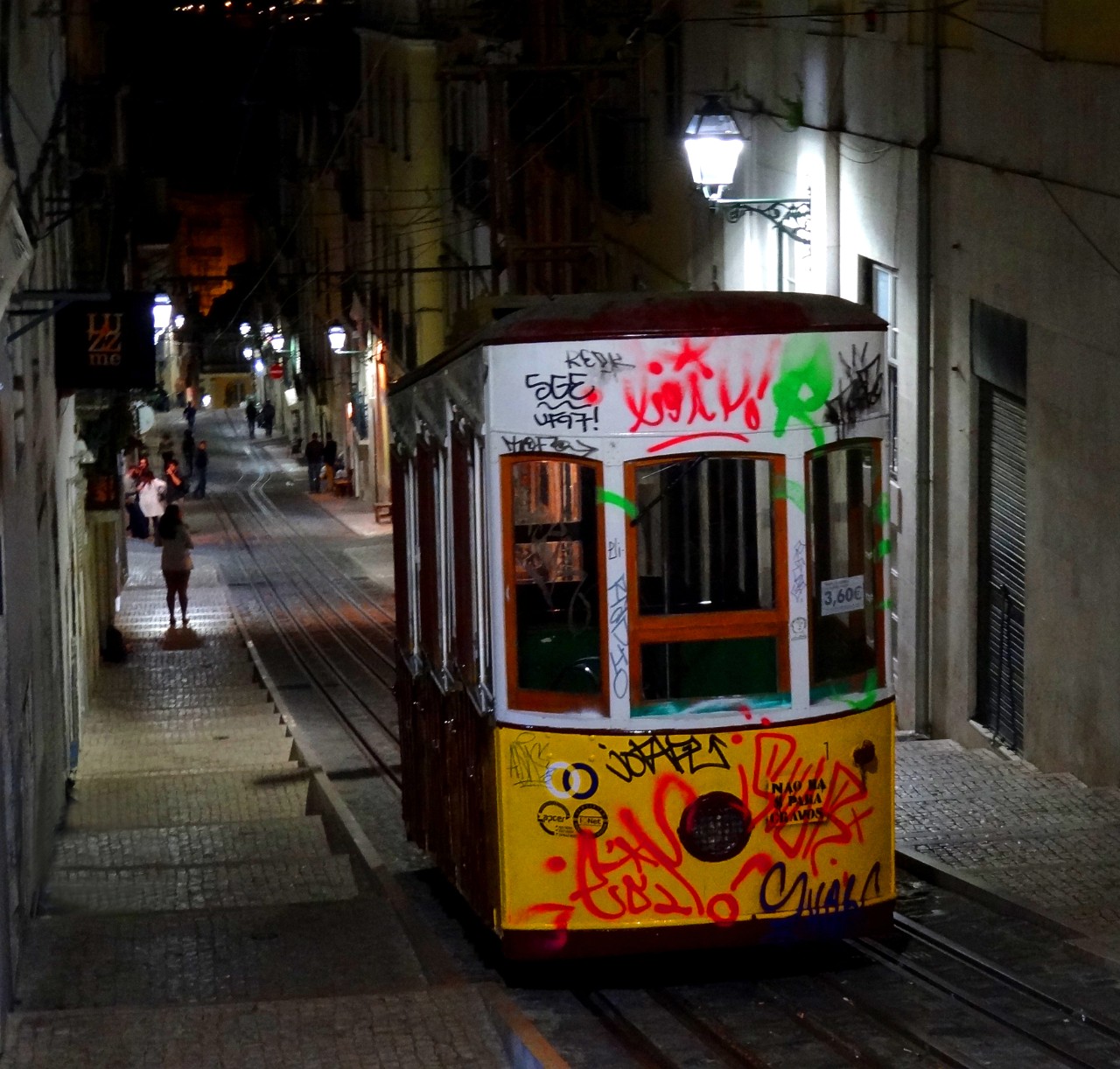
Rua da Bica Tram
Lisbon is a big capital city, and yes the popular sites were crowded, but nonetheless there was something intangible about Lisbon that just felt easy.
Follow me on my Instagram account Travelknowing for more Travel series, after all…knowing is everything!








Lovely post, Rebecca! It is good reading all in one go…and all the history you have described is quite fascinating. Beautiful photos as well. Will be a good reference when we visit Lisbon!
Dhara recently posted…Two Days in the Magical Cinque Terre: A Taste of The Ligurian Coast of Italy
Thanks Dhara! It’s fun to do an Instagram series and then put it all together in a post. I hope you find the tips useful on your visit to Lisbon!
Rebecca recently posted…Death Valley Road Trip – Two Nights in Death Valley
Great photos Rebecca! Memories of our month there in 2016…and reminders of all the tourists! But it certainly is a photogenic place. Our favorite places: Jeronimos monastery and the Tile Museum.
Frank (bbqboy)
Frank recently posted…Looking back at 2017â¦and forward to 2018 (it will be a year of changes)
Yup, we had our share of waiting in lines in Belem and I gotta say that tram was way overrated! But I loved our 10 nights in Lisbon, there was so much more to do that we didn’t get to. Thanks for your comment Frank, it’s always fun re-visiting a place through photos!
Rebecca recently posted…Bodie – The Most Fascinating Ghost Town You’ll Ever Visit